One of the joys in working with internationals is to experience new things because of cultural differences. Such differences can help broaden our understanding of the world, help us appreciate different values, and try things for the first time. Some of us are more adventuresome than others when it comes to trying new foods. This can prove to be a dilemma when we are offered foods we are not sure we would like. How should we respond?
Leviticus 11:1-23 is a long recitation of the foods that the Israelites were told not to eat, for they are unclean. Many centuries later, the Lord lifted these restrictions by telling Peter not to refuse to kill and eat foods that God had made clean. (Acts 10:15; 11:9) Some of us may share Peter’s initial response to unfamiliar foods. But as He did with Peter, our Lord reminds us that He made everything and He can enable us to receive unfamiliar foods with gratitude. In Romans 14:14a, Paul provides further encouragement: “I know and am convinced on the authority of the Lord Jesus that no food, in and of itself, is wrong to eat.”
1. Haggis
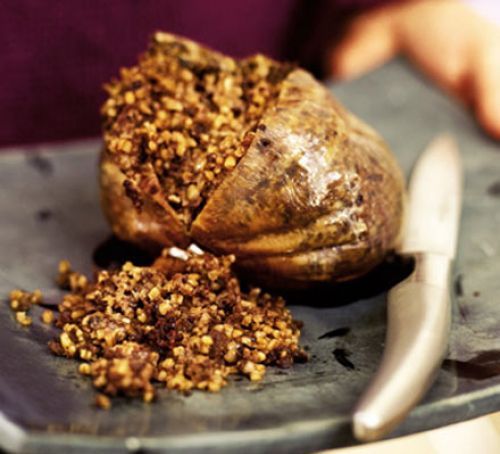
Haggis is a “pudding” made of finely chopped sheep’s heart, liver, and lungs as well as onion, oatmeal, suet, salt, and spices and–in its traditional form—encased in the sheep’s stomach before being boiled. (This is Scotland’s national dish.) Thought to have originated in Scotland, there are records of that the Romans, Greeks, and Vikings ate something similar. One food writer suggests that haggis was created as a way to use prey’s internal organs quickly after a hunt. Haggis may have been boiled in a vessel made from the prey’s skin, for ancient huntsmen carried no cooking pots. Although originally a hunter’s dish, there are vegetarian and even vegan versions of this dish!
2. Fish head soup
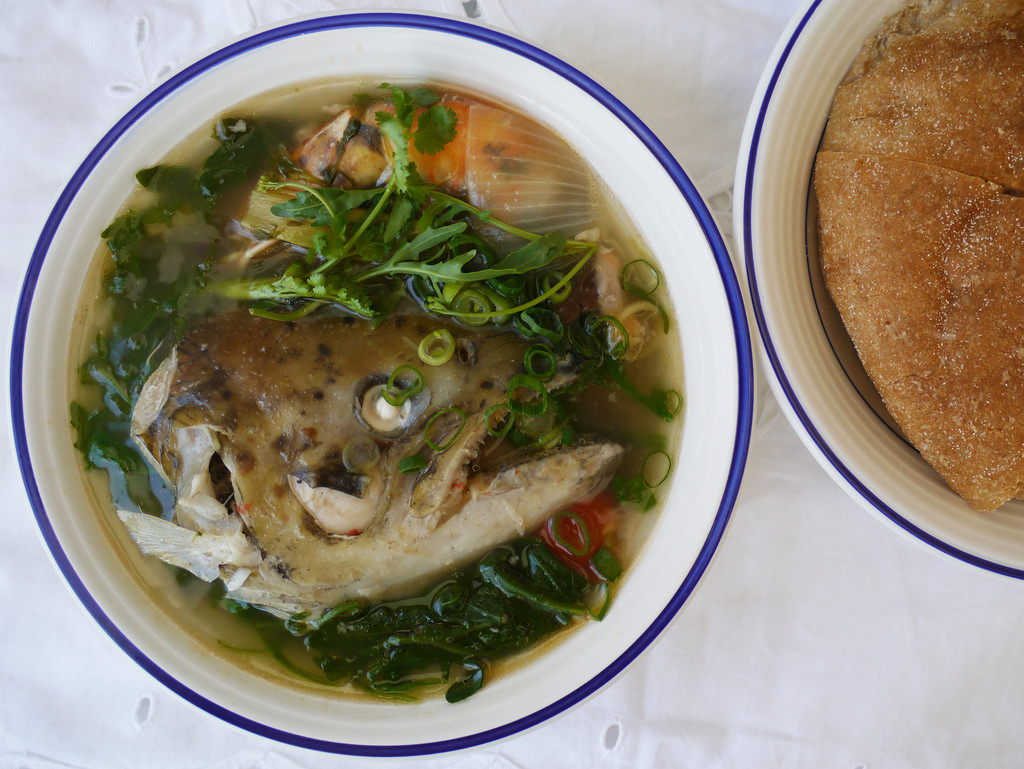
Fish head soup is made of, well, fish heads. Quotes one Asian culinary writer, “Fish heads are good eating and the eyeballs, the crowning glory. There’s a lot to be enjoyed from excavating the head of a fish. Besides the eyeballs, most heads contain a sizeable section of flesh [brains] as well as some of the most delicious cartilage in existence in the greater animal kingdom.” In the 1970s and 1980s, many American grocery stores were happy to give away or sell fish heads at a very low price. Fish heads weren’t something that Americans wanted to see, much less cook! But when American grocers realized how their Asian customers prized fish heads, they raised the price!
3. Eel
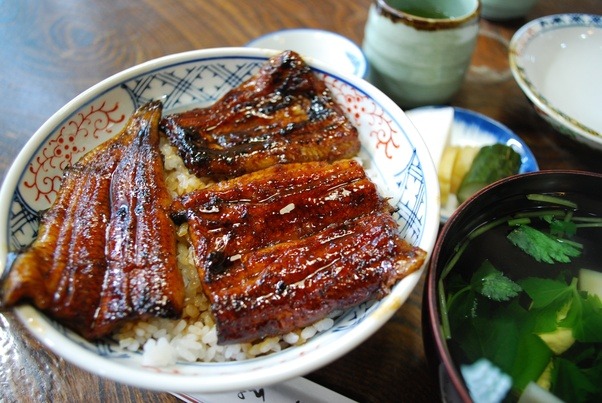
Eel is a delicacy in Chinese and Japanese cooking (called unagi fish in Japan). My first introduction to eel was in an open-air market in a remote village in Sichuan Province in China, where I watched a fisherman behead and strip the innards from freshly caught eels. That night, one of the dishes my hosts ordered at a local restaurant for us visiting English teachers was eel. The bones were still in it! What to do with them? Valiantly, I tried to chew them. (Not fun. Not tasty.) As I returned to our table after a trip to the restroom, I saw that the floor under the table was littered with eel bones! How did our hosts do it? Never once had I seen anyone spit out the bones! I’d put squid (calamari) in the same category as eel: if you haven’t grown up eating it, it definitely looks like a foreign food, although when cut into rings and deep-fried, it can look not quite so foreign. Unlike eel, squid has no bones.
4. Congee
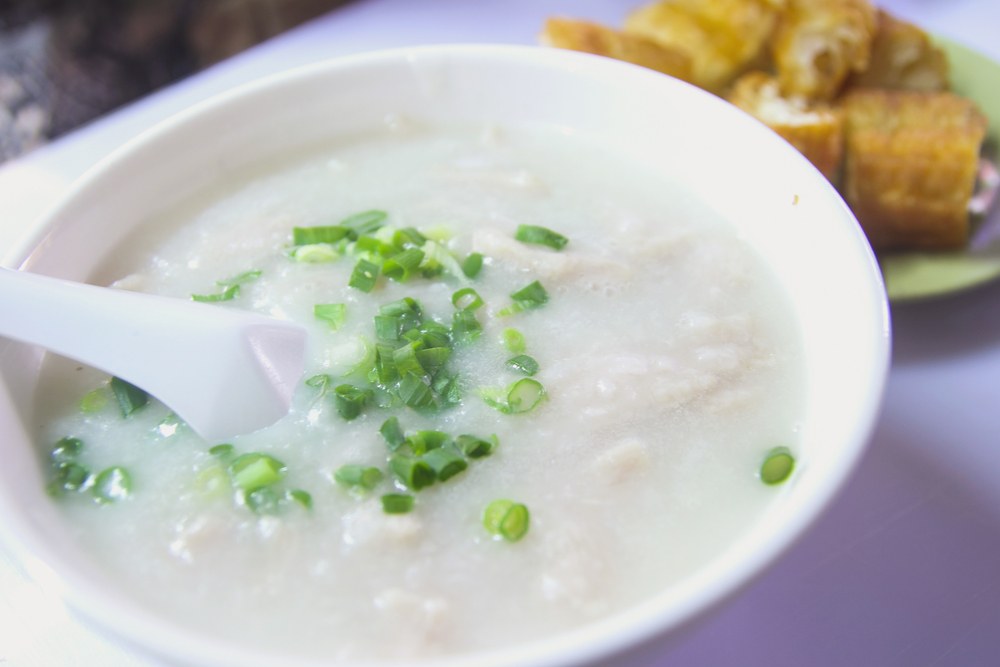
Congee (rice gruel or porridge), is made with white rice and, possibly, some mung beans. It may be served plain or accompanied by shredded pork, egg, deep-fried dough stick, sliced ginger, beans, and vegetables. Millions of Asians begin the day with a bowl of congee. The gruel itself is very bland. The texture may not appeal to westerners who don’t care for creamed foods. However, there are about as many ways to prepare this dish as there are cooks! Some versions are sweet, but most are savory, and, I’ll admit, pretty good! A sweet variation on the plain rice porridge is ba bao zhou (Eight Treasure Cereal), which I’ve made for many Asian guests. For a version many Americans will like, see the recipe at the end of this article.
5. Century eggs
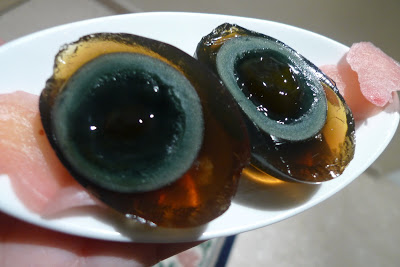
Century eggs, hundred-year eggs, preserved egg, and millennium eggs are names for the same ancient approach to preserving duck, chicken or quail eggs: wrapping them in a mixture of clay, ash, salt, quicklime, and rice hulls for several weeks to several months, depending on the method of processing. The result is a dark-green-to-grey yolk of a creamy consistency and strong flavor from the hydrogen sulfide and ammonia that develop in the process. The white becomes a dark brown, translucent jelly with a salty flavor. This technique likely came about through the need to keep eggs in times of plenty for the lean days of winter or drought. Tea Leaf Eggs are more acceptable to most western palates. See an easy recipe for tea eggs at the end of this article.
6. Invertebrates

Invertebrates of all sorts, including fried scorpions and other fried, boiled, and roasted insects—served on a skewer for easy eating as one strolls–were among the street foods offered to visitors at the 2008 Olympic Games in Beijing. Grubs and other insects are an important part of the diet in many countries. As one African farmer told an American farmer, “When you see a swarm of locusts approaching, you see disaster. We see a feast!” See below for recipes for more palatable alternatives.
Saying “No” Politely
Keep in mind that the unusual food your host is offering you may be considered a delicacy in his/her culture. Your host is honoring you with such goodies! It is culture that causes you to see it differently.
Here’s a story about a local delicacy seen from different points of reference:
An American missionary was sitting by the fire, where his African friends were roasting grubs on sticks for the evening meal. Suddenly the American realized it was Thanksgiving Day in the US. As he thought of the meal that his relatives were eating, he felt sad about his campfire dinner. A native who saw his downcast expression said with compassion, “I know what you’re thinking: The grubs in my village are much better than these!”
The following are some ideas for polite responses and refusals when you are offered unfamiliar food that doesn’t look appetizing. The ideas involve shifting focus—yours and your host’s. Focus first on the food, then on the hospitality, and finally on the host.
Buy some time to hear God. Say something like, “Oh my! This is new to me! What do you call it? How is it prepared?” This will divert your host’s attention from your less-than-enthusiastic response and get him/her to explain what the food is and how it’s prepared, giving you time to ask God what to say next!
An always-acceptable way to decline the offered food: If you’re allergic to the food or to one or more of its ingredients, tell your host, with great regret, that you are allergic and might become ill if you eat it. Apologize for not telling your host in advance of your food allergy, sensitivity, or intolerance. Since food sensitivities seem to be fairly common now, most hosts will understand and share your regret.
If you don’t have such food sensitivities, a truthful way to say that you can’t possibly eat the food is, “Oh, my! You’ve prepared such a special dish, but my stomach has reacted badly to similar foods. I’ll take a small taste, but I know I shouldn’t eat much. I am so sorry!” Thank your host for introducing you to new foods from his culture.
Ask if your host often eats this dish. His/her answer may indicate whether the food is common (and likely not costly) or an expensive delicacy. This question will buy you more time to listen to God guiding you to a way to avoid being given a large serving, which you might eat, pretending that you enjoy it, causing your host to insist that you have more!
Ask if you may have a very small portion to try, saying, “I like adding new friends to my life, but I’m not very good at adding new foods to my diet. Thank you for giving me a chance to try this. I hope you will understand if I don’t like it at first!”
Pick the food up and smell it, commenting on your perception of one or more ingredients that your host named. Prepare your host for your gentle refusal by saying that you’ve never eaten it before.
Taste it. When everyone has begun to eat, take a small taste, closing your eyes as you smell it again. (Sometimes not looking at it helps!) Ask God to help you respond graciously. Be prepared to like the food or at least find it not as bad as you anticipated! If it is as bad as you feared (or worse), and you are the only guest and everyone’s watching, ask the Lord to give you grace to eat a little of it. You can honestly comment, “Very interesting! I’ve never tasted anything quite like it!” Nibble a little more, then leave the remainder on your plate or in your bowl. In many cultures, eating all of a food is a signal to the host that you want more, so be sure to leave some uneaten to signal that you’re satisfied with what you’ve had.
Divert attention to other foods and the host’s experiences. Instead of focusing on the food you dislike, ask for more of the foods you do like. Say how much you enjoy them. Ask how they were prepared and whether your host prepared them. This will honor your host. Ask your host what American foods he doesn’t care for and how he handled his first encounters with them. (Do a little research on the Internet beforehand so you can ask about specific foods such as cheese, pizza, grits, icing, etc.)
Move the conversation away from food. Be ready with a few good stories to tell. (One of them should be how you realized your need for a savior and how you became a follower of Christ!) Ask your host to tell you about his work, life, family, ancestors, early school experiences, favorite memory from childhood, sports they enjoy, special holidays and how they celebrate them, etc. Ask how he/she approached a life event that you are facing, eg, teaching a toddler to share, preparing a child for the first day of school, sending a child to college, handling a difficult coworker or boss, etc.
Be grateful. In Romans 14:6b, Paul exhorts us to honor God in all our thoughts regarding food: “Those who eat any kind of food do so to honor the Lord, since they give thanks to God before eating.” No matter what you thought of the food, thank the Lord and thank your hosts for preparing it and inviting you to eat with them. Ask how to prepare a food you especially enjoyed and where to purchase the ingredients. This assures your hosts that they’ve pleased you.
Thank your hosts again as you leave, keeping in mind Paul’s wise words in Romans 14:17: “For the Kingdom of God is not a matter of what we eat or drink, but of living a life of goodness and peace and joy in the Holy Spirit.”
Bonus: 2 Recipes to Try!
Chen Jian’s Ba Bao Zhou (Eight-Treasure Cereal)
12+ servings
This recipe is from a good Chinese friend who cooked many lunches for me.
In a large slow cooker filled 2/3 with water, put these ingredients purchased from an Asian grocery. Cook on HIGH for 4 hours or more, stirring occasionally:
½ cup dried red dates (pitted or whole)
½ cup dried chestnuts
½ cup small red beans
½ cup dried lotus seeds
½ cup raw peanuts, blanched (sometimes I use roasted, unsalted peanuts)
½ cup red or black rice, rinsed (optional)
½ teaspoon salt
Stir in:
½- 1 cup sweet (sticky) white rice
½ cup dried fruit (raisins, dried cranberries, apricots, figs, etc.) or a can of pineapple tidbits
½ cup pearl barley, rinsed and checked for small stones
1 stick brown sugar candy or other sweetener, to taste
Enough water to almost fill the slow cooker
Stir occasionally. (Rice may clump on the bottom if you don’t.) Cook on LOW 4 – 6 hours or overnight, until beginning to thicken and the rice is tender. (Usually it thickens as it cools.) Stir well before serving. May be eaten hot, warm, or cold. (I like it with milk.)
Tea Leaf Eggs
6 servings
The recipe can be multiplied, based on the measurements for 6 eggs; for 3 dozen eggs, use only 7-8 tea bags. Feel free to use more or less of other ingredients to achieve the flavor you like.
Hard boil 6 eggs: Bring eggs to boil, remove from heat, cover, and allow to sit for 15 minutes, timed. Cool by draining off hot water and covering eggs with ice water.
With the back of a heavy spoon, tap the cooled eggs gently all over until the shells are covered with a network of fine cracks.
Cover cracked eggs with cool water and add:
1/4 cup soy sauce
1 whole or 8 sections of star anise
2 tsp black loose-leaf tea (a grade of Orange Pekoe) or 2 tea bags of black tea
Bring eggs to boil over high heat, then reduce to lowest point, cover, and simmer for 2-3 hours.
Check from time to time, and if the liquid is getting low, add enough boiling water to cover.
Turn off heat and leave the eggs in the tea liquid at room temperature for 8 hours.
Just before serving, remove shells carefully. (If serving a crowd, your guests can peel the eggs they eat.) To serve, put whole eggs in a bowl or slice and arrange them on a plate.
NOTE: If you are not going to serve the eggs right away, please refrigerate them



